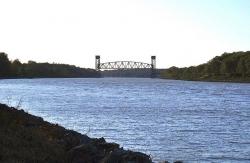
The Chesapeake & Delaware Canal is the only canal built in 19th-century America that still operates today as a major shipping route. Connecting the Port of Baltimore and Upper Chesapeake Bay with the mouth of the Delaware River and the Port of Philadelphia, the canal was one of the first civil engineering projects proposed in the New World and one of the most difficult to carry out. Although only 14 miles long, the canal's original cost made it one of the most expensive canals ever built in America.
The main reason for the canal's great expense was the cost of excavating a three-mile section known as the "Deep Cut," a portion of the channel that crossed a low ridge of the Maryland-Delaware peninsula and cut through terrain composed mainly of boulders, gravel, sand, clay, and water. Once completed, however, the Chesapeake & Delaware Canal proved to be of great value to the shipping industry in shortening the trip from Baltimore to Philadelphia by nearly 500 miles.
Facts
- Early in its operation, the canal experienced low levels of water from evaporation, bank seepage, and losses during normal locking activity. To compensate, a steam-operated pump was installed in 1837 to raise water to the canal from a nearby creek. In 1852, the pump was replaced by a steam engine and large waterwheel, used to lift water to the canal. In 1854 a second engine was added, and both engines remained in use through the 1920s.
- The canal's original pump house has been restored and today operates as a museum and visitor's center. Among its exhibits are the two steam engines installed in the 1850s, which are the oldest steam engines still on their original foundations in the United States.
- As a toll canal, the Chesapeake & Delaware experienced its peak in 1872 -- carrying more than 1.3 million tons of shipping cargo -- one of ten years in which annual shipping use exceeded one million tons.
- The original canal -- 14 miles long, 10 feet deep, and 66 feet wide -- contained three locks and was operated as a toll canal until 1919, when it was purchased by the U.S. Army Corps of Engineers and converted to a sea-level canal without locks.
- While under the jurisdiction of the U.S. Army Corps of Engineers, the Chesapeake & Delaware has been expanded three times, once in the 1920s, once in the 1930s, and again in the 1970s. It is now 450 feet wide and 35 feet deep.
- The Chesapeake & Delaware Canal provides a vital link in the Atlantic Intracoastal Waterway which extends from New England to Florida. According to the Corps, it carries 40 percent of all ship traffic in and out of the Port of Baltimore.
Resources
-
Ralph D. Gray, The National Waterway: A History of the Chesapeake and Delaware Canal, 1769-1985; University of Illinois Press, 1989, ISBN 025 2060660.
-
Vogel, R.M., Roebling's Delaware and Hudson Canal Aqueducts, Washington, D.C., Smithsonian Institution Press, 1971.


